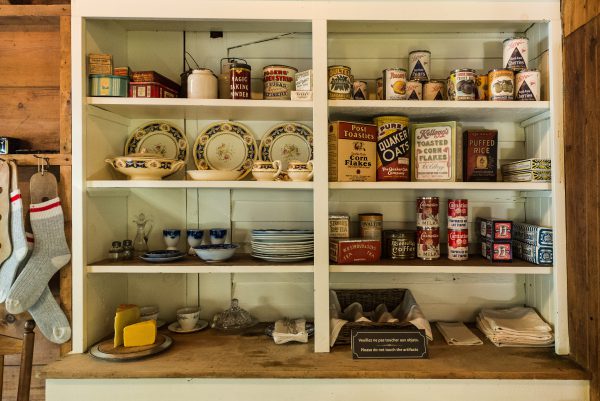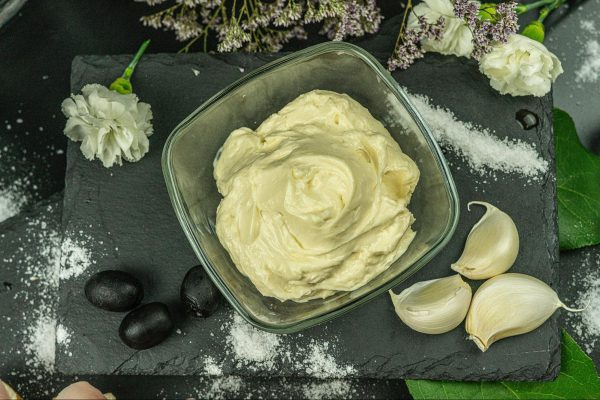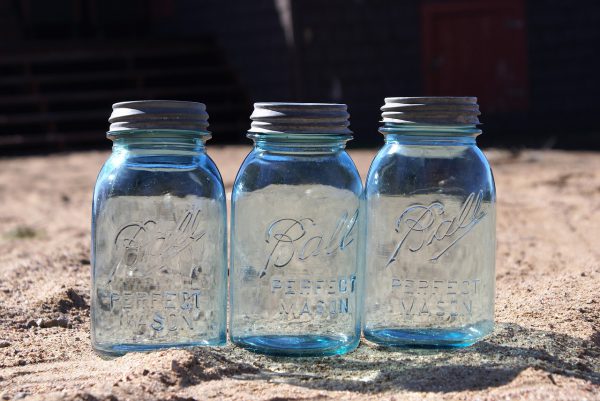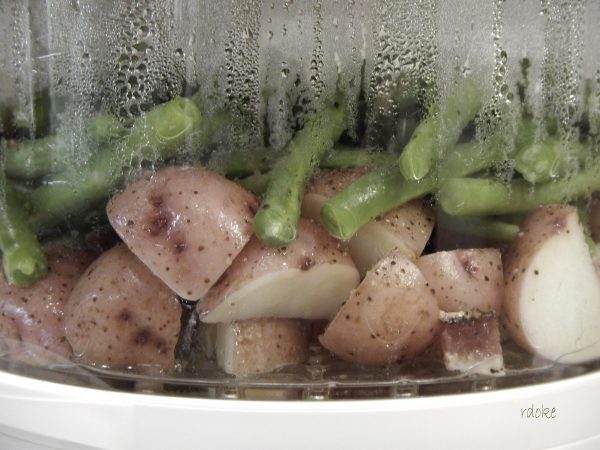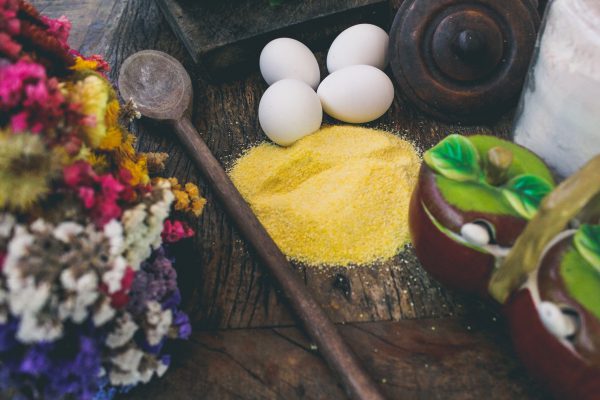Last Updated on November 22, 2022
A must-have for any kitchen, mortars and pestles are the bedrock for most culinary traditions throughout the world. With the invention of electronic food processors, the mortar and pestle has been wrongly left out of many kitchens. They’ve become a decorative item or have disappeared altogether and this has left home cooks without a crucial tool in the kitchen.
This article was brought to you by KROK, a small business that preserves and promotes the Thai tradition of handcrafted granite mortars and pestles.
No gadget can smash ingredients like a mortar and pestle, breaking down cells and fibers to release hidden oils and aromas. Whether you try dicing with a knife or turning on an electric grinder, slicing an ingredient smaller and smaller with a sharp object will never accomplish what the mortar and pestle can.
So now you’re ready to purchase your first mortar and pestle. There are so many shapes and sizes, made from numerous materials. How do you avoid purchasing a useless mortar that ends up becoming a decorative flower pot? How do you know if you’re getting the right one for your kitchen? Easy! Let’s find out.
What to Look For While Shopping for a Mortar and Pestle
When looking for your mortar and pestle, there are three main concepts to remember:
Mortar and Pestle Size
The first and easiest thing to look for in a mortar and pestle is the size. With size, you want the mortar to be large enough to handle multiple ingredients. There’s no reason to get a small mortar and then have to deal with ingredients flying out of the bowl as you attempt to smash them. And since you have a large mortar, you will also want a large pestle that is long enough to avoid hitting your hand on the side of the mortar while using and wide enough at the bottom of the pestle to strike the ingredients instead of just pushing them around the bowl. Kitchen space might be a limit for some but you shouldn’t have one any smaller than a three cup volume if you’re going to be putting in multiple ingredients. If you plan on using the mortar for single ingredients as a spice grinder, this larger size will be unnecessary. You might just need a small mortar on hand for quick and easy grinding of single ingredients and a larger one in the cabinet for recipes with multiple ingredients.
Mortar and Pestle Shape
The shape of the mortar should be a round bowl shape with no corners at the bottom. Any corner will make it difficult to grind ingredients if they can hide from the pestle. There are some types of mortars that have a more cylindrical shape but they are usually for very specific uses and won’t be as generally useful for your first mortar purchase. On the outside of the mortar bowl, some mortars will have bumps or other features to help with holding mortar and you pound with the pestle. This isn’t necessary but some cooks might prefer a little help handling the mortar.
Mortar and Pestle Material
What the mortar (and pestle) is made out of is very important to its usefulness. For general use, the best option would be to get one made from a solid stone material like granite or marble. These stone mortars and pestles will use their heavy weight to break down the ingredients and they will also be able to withstand years of pounding and grinding without needing to ever replace it. Mortars made from weaker materials like wood, ceramic, or some type of light metal just won’t have the strength to break down the ingredients to where they need to be. As an additional material, some mortars will have a silicone or rubber bottom. This can be very helpful to make sure the mortar doesn’t slide around as grind and pound ingredients and will also dampen some of the loud knocking noises while using. Not every mortar has this so if it’s something you’d want, be sure to verify the mortar you’re buying has it.
Choosing the Best Mortar and Pestle
Now that we’re able to start looking at the different styles based on the three above criteria, it’s time to choose the best mortars and pestles for you, depending on the uses you need them for in your kitchen.
Thai Granite Mortar and Pestle
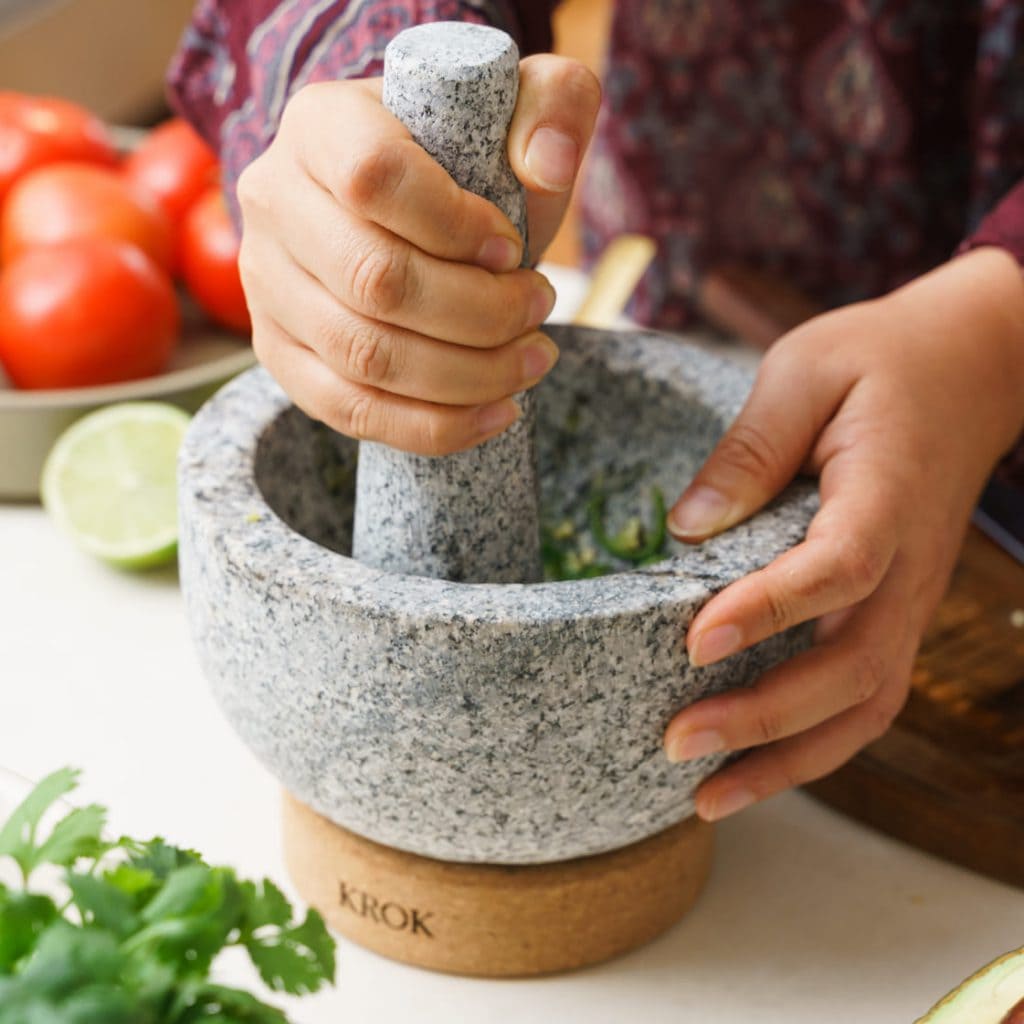
The most versatile mortar and pestle you can buy is the Thai-style granite with both the mortar and pestle being made from solid granite. This mortar and pestle will handle any ingredient thrown into its bowl, from the toughest chili skins and fibrous roots to soft herbs and spices. If you plan on making any type of paste or curry, this is the tool for you. The heavy weight will break down dried chilis, ginger and galangal roots, and any type of leaf. Because of the unpolished inside of the bowl and end of the pestle, this mortar can also handle the simple grinding of any spice. Whether it’s the first ingredients of a paste or the recipe calls for certain ground spices, swirling the pestle around the mortar bowl will create fresh, incredible flavors. The best option is the KROK mortar and pestle, which is handcrafted in Thailand. The 3-cup capacity will be able to handle most recipes you want and the heavy weight can crush any ingredient. The cork base dampens the noise you create while pounding and stops the mortar from slipping and sliding around on your countertop. Also, the pestle is longer than usual to keep your hand away from the edge of the mortar while using it. If your kitchen style leans more Mediterranean with sauces and creams, the Thai granite can handle these as well. A pesto will come out better than any electric food processor but you might decide what you want is the next style…
Buy a KROK Mortar & Pestle here
Italian Marble Mortar with Olive-wood Pestle
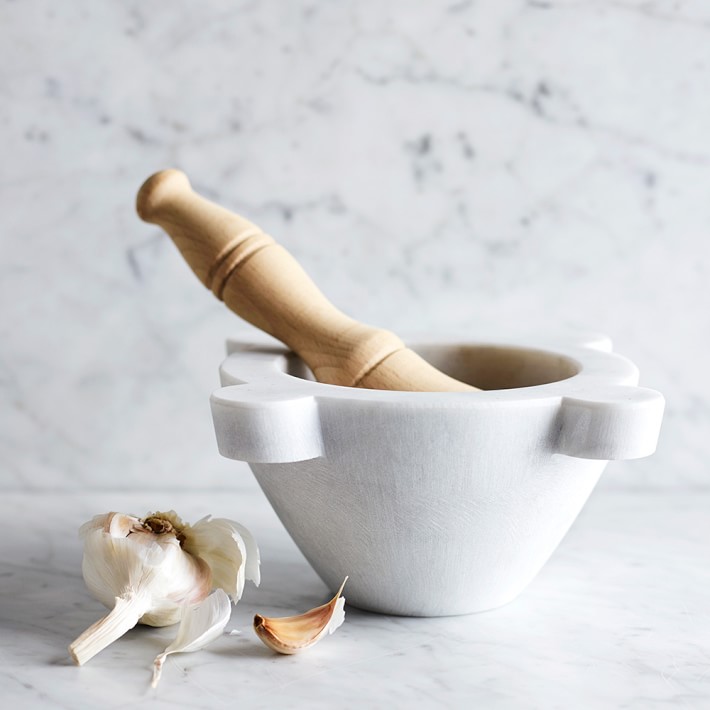
While the heavy granite can handle the more delicate ingredients of pesto and similar sauces, it won’t perfectly recreate the creamy, emulsified sauce that you can get with a large Italian marble mortar with a wooden pestle. With the round and large tip of the wooden pestle, the basil leaves, garlic, and other tender ingredients will be properly broken down in this mortar. The pestle being lighter will also make the work less tiring than pounding with the granite pestle for these quicker sauces.
With all that said, the Thai granite is still probably a better first purchase. The light materials of the wooden pestle just cannot break down difficult ingredients in any way similar to the heavy Thai granite or a marble pestle. Also, the granite mortar and pestles are usually cheaper and easier to find online or in kitchen stores. Whether you’re taking a chance on a marble mortar on Amazon or buying a handmade one from a reputable online dealer, you probably won’t find a marble mortar and wood pestle under $100.
If you aren’t planning a trip to Italy soon, this 20cm one on Amazon will be a great option. The capacity is closer to 2 cups but should be ready for any pesto or cream you want to make in it. The white marble will look beautiful in any kitchen and was made in Italy!
Small, Single-Ingredient Mortar and Pestle
Another option to consider is a small mortar and pestle that you can use for grinding one or two spices at a time. You won’t be making any sauces, creams, or curry pastes in this mortar but any time a recipe calls for a ground spice, this is perfect. Using a mortar and pestle will be quicker and easier than even an electric spice grinder and the clean-up is much less of a headache. Using freshly ground spices from your mortar and pestle will heighten the flavors of any recipe that you might already be creating in your kitchen. You can grind the spice down to as fine or coarse of a powder as you want. Just starting with a bit of simple black peppercorn ground in your mortar instead of grabbing the pepper shaker will surprise you with new depths of flavor.
This mortar and pestle should be a solid stone material as well. Avoid the cute ceramic, wood, or brass mortar. They look pretty on the counter but will not break down your spices. Similar to the larger ones recommended above, solid granite or marble (with marble pestle) will be good options for you to purchase. If you want a marble one (maybe to match the large one you’ve already bought), this 6-oz one from Norpro is heavy enough to crush 1 or 2 ingredients at a time. If you’re looking for granite, grab this one from Gramercy Kitchen Company. Even with its small size, it has impressive weight for crushing ability and a nice pad on the bottom to keep it from moving around on your counter.
Additional Mortars and Pestles for More Specific Uses
So far we have focused on only two main regional types for their versatile uses but almost every culinary tradition throughout the world has their own variations of this tool since it is one of the earliest kitchen tools used by humankind. Even Thailand (and Southeast Asia in general) have more styles than the large granite one listed above. But to not overwhelm you with the endless options of mortars and pestles from around the world, there are just two additional styles that might need a home in your kitchen. These are unique for their specific designs and purposes and they’re special because they are some of the most beautiful pieces of kitchenware still used today.
The Molcajete – Mexican Mortar and Pestle
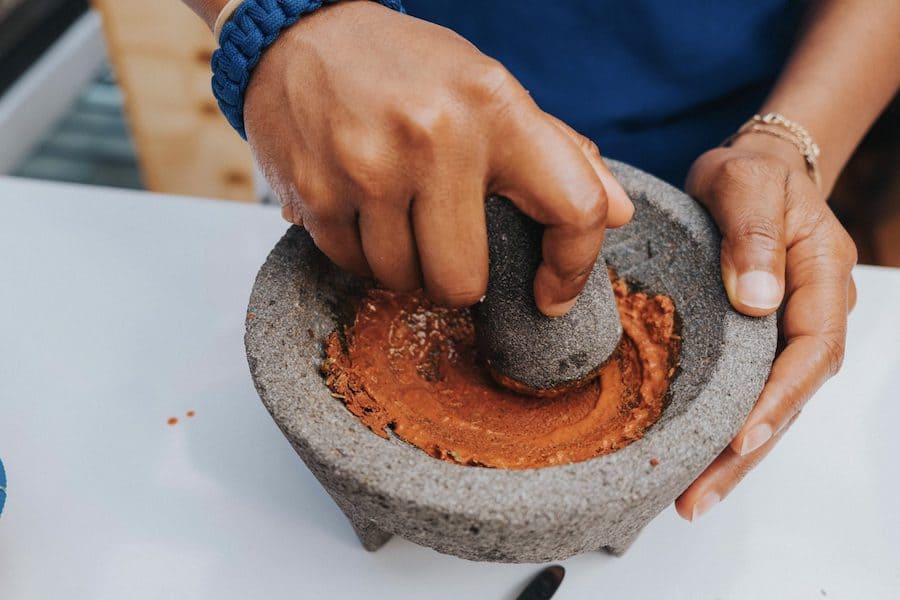
If you have ever ordered guacamole at a restaurant that was made at your table, you have most likely seen the molcajete. This is Mexico’s version of the mortar and pestle made from porous, volcanic rock that is perfect for making guacamole or salsas. Both soft chunks of avocado or tomatoes and more difficult pieces of chiles can easily be broken down by the molcajete. A quick note about the molcajete is that unless you’re buying a pre-seasoned one, there is a bit of a process to prepare your molcajete for use once you get it. This process includes grinding dry rice and salt until all the loose volcanic dust is removed from the inside of the bowl.
Unless you’re able to go to Mexico and grab one at a local market, this one from FESTMEX will be the best, most affordable option for you. The 2-cup capacity is perfect for making and serving guacamole or salsa. Make sure to follow the instructions to season your molcajete before first use!
The Suribachi – Japanese Mortar and Pestle
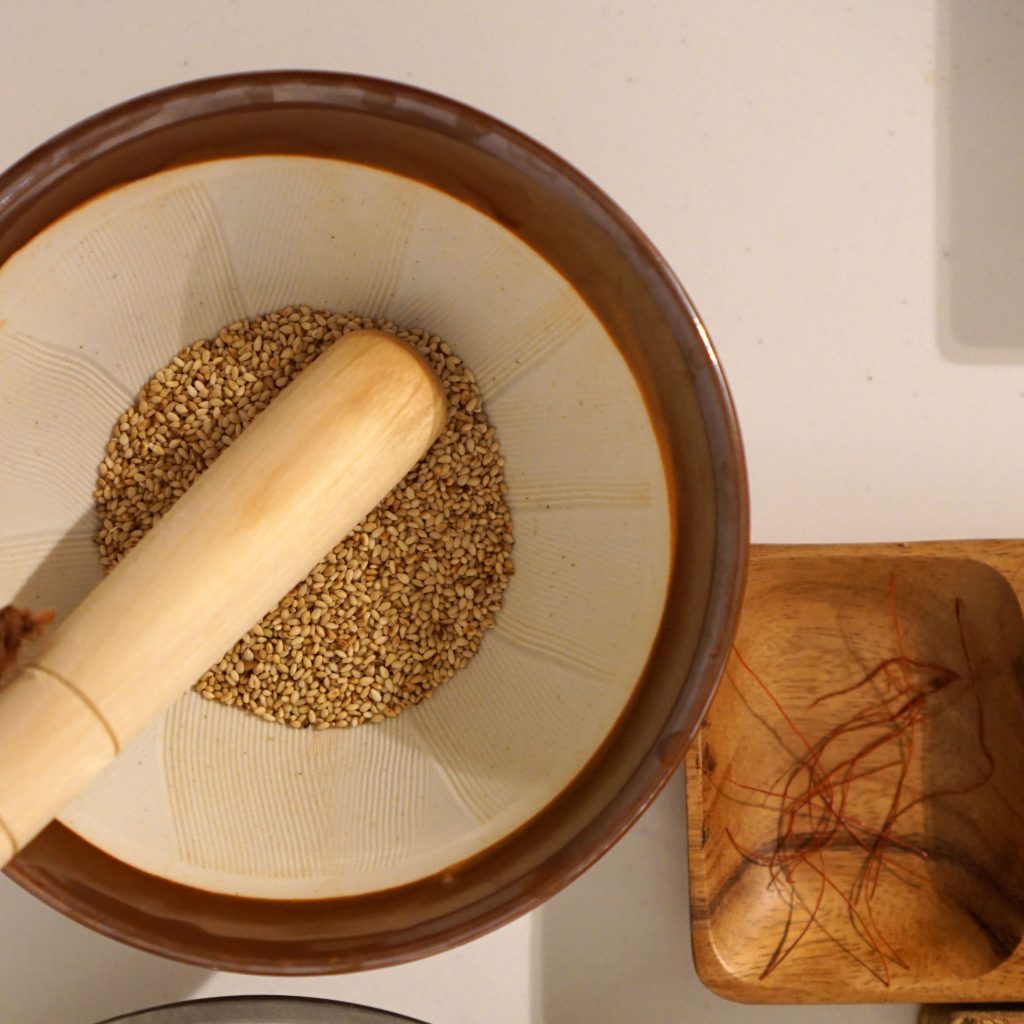 This pottery-made mortar from Japan has ridges cut into the inside of the bowl. With the wooden pestle, you swirl the ingredient around as the ridges crumble everything down into a powder or paste. The most common use for the suribachi is sesame seeds but you’ll see it used on spices, tofu, and even meats for certain recipes. If Japanese recipes find a place in your kitchen, this might be the exact tool your taste buds have been looking for.
This pottery-made mortar from Japan has ridges cut into the inside of the bowl. With the wooden pestle, you swirl the ingredient around as the ridges crumble everything down into a powder or paste. The most common use for the suribachi is sesame seeds but you’ll see it used on spices, tofu, and even meats for certain recipes. If Japanese recipes find a place in your kitchen, this might be the exact tool your taste buds have been looking for.
If you’re ready to purchase a beautiful suribachi, grab this one by Mino Ware off of Amazon. It’s a medium sized mortar so is perfect for grinding sesame seeds but will be ready for any adventures your recipe has in store for it. Also, the ridges on this suribachi go in two directions so it can be used by left-handed and right-handed cooks.
Now that you understand what to look for when shopping for your mortar and pestle and you now know many of the most common styles of mortars and pestles, you’re ready to get one in your kitchen and start pounding, smashing, and crushing ingredients. Any recipe you have will benefit from having freshly ground spices and once you’ve created a homemade curry paste or pesto, you’ll never go back to purchasing pre-made again. If you’re still not sure what mortar and pesto you want to buy, check out our Top 12 Mortars and Pestles for our recommendations.


